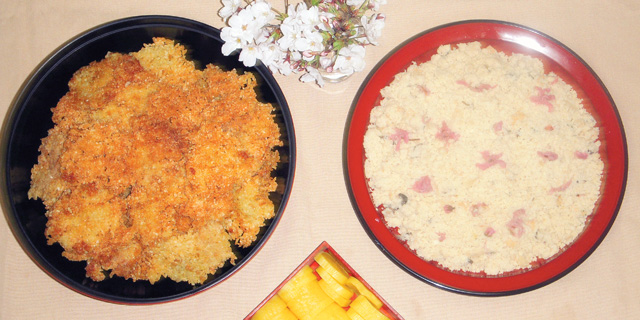Gourmand Dietary Culture
- TOP
- ESSAYS
- Gourmand Dietary Culture
- Cherry Blossom Treats
Cherry Blossom Treats
vesta No. 79
Cherry blossom [hanami] treats (rolled and fried egg, pot-bottom [kamazoko], cheap sushi [naga-inari]
It's not quite the season any more, but let's talk about cherry blossom [hanami]!
Every year since 1981, Professor Gourmand has hosted a hanami party. It started out as a modest party with colleagues from the National Museum of Ethnology. But living according to the principle of "not turning anyone away," I kept inviting people, until now the regulars come in at around 100 people. It has become the major event of my spring.
Anyone can attend the hanami party, but since its inauguration there has been the rule that "attendees have to bring either something to eat or drink." Even buying a single bento box at the convenience store qualifies you to join. Some years it's all food and very little to drink, other years its only alcohol without any side dishes, but that's all part of the charm.
The tendency to "gather and splurge" for hanami parties has its origins in comic story telling [rakugo]. The Tokyo rakugo story "Row House Hanami," and the Kansai rakugo story "Paupers Hanami" tell the story of poor people living in row houses bringing one item of food or drink (not alcohol, but tea) to gather together for hanami in a kitchen. Apparently the kansai story "Paupers Hanami" came first, and then it travelled up to Tokyo in the Taisho period to be performed as the same story but under a different title, "Row House Hanami."
This year's hanami party was held in Nara. I couldn't host it at the spot in Osaka with many cherry trees that I wanted, so I rented a roof terrace beer garden in Nara that's usually closed until summer, and we admired the cherry blossoms blooming on Mount Wakakusa through a telescope. This year, I went back to the original model, and brought row house hanami treats. I selected them from the menu in "Paupers Hanami," played by the Katsurabeicho Group. First "rolled and fried egg." In the rakugo, someone asks: "isn't that pickled daikon [kōko]?" and someone answers: "the colour is similar." Really it's a market radish that has been painted bright yellow, cut up, and put in a little box. Next is pot-bottom. Sadly not, fish sausage. One asks: "calling this fish past [kamaboko], you!... this is just burned rice, isn't it?," "It has the shape of a pot, doesn't it?... That's what I'm saying! Kamazoko, bottom of the pot!"" They joke about the burned bit on the pot bottom being called kamazoko [meaning pot-bottom] rather than kamaboko [meaning fish paste]. If I made a load of actual burned stuff, surely no-one would eat it. Using Chinese burned cooking made using a casserole, as a reference point, I tried making vaguely edible burned food. I mixed up rice and mincemeat, then I cooked it in consommé stock with curry powder. Then I rolled the rice mixture into a ball roughly the size of a pingpong ball, put it ontop of a well-oiled hot plate, pressed it down with my palm until it was flat, and fried it until it was a burned colour and gave out an aroma.
In the Tokyo version, "Paupers Hanami," they mistake daikon cut into half-moon shapes, or pickled white daikon for pot-bottom [kamaboko]. Someone suggests: "When I have a stomach ache, I have grated kamaboko." [The joke is that grated radish is known as a home remedy.] One last dish resembles mackerel, called "naga-inari." "I'm saying, if you don't cut the soy pulp [okara], you've got naga-inari." It's a fried dish made from the refuse from tofu. I added dried shiitake mushrooms to cherry blossom soaked water. Then I threw the soy pulp [okara] into frying oil, added dashi and light soy sauce. I then pickled all this in the cherry blossom and shiitake stock. It was a refined dish that had the scent of pickled cherry blossom.
While I was making this food, it occurred to me that "row house" cooking was a product of Edo Period culture. Ever since rice was introduced to Japan, people would have been able to eat burned pot-bottom. But it must only have been with poorer people eating just rice, not a whole meal, as in Edo Period towns, that people began eating burned white-rice. There must have been fewer opportunities to make soy pulp [okara] recipes in the countryside, where it was "8 miles to the liquor store, and 5 miles to the tofu store." Pickles, like radish, also became popular from the Edo Period onwards. The kind of food that was available in poorer people's row houses, was not the kind of food you could eat in the countryside.

